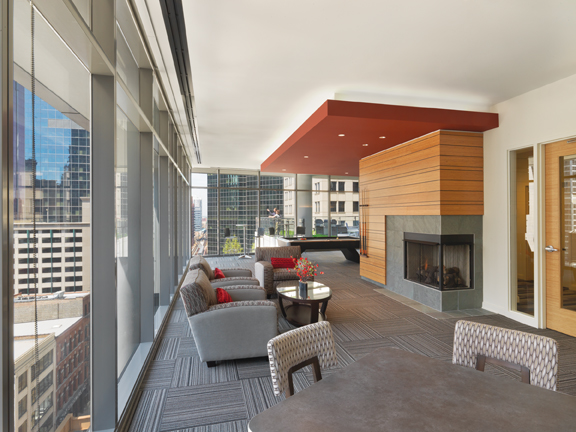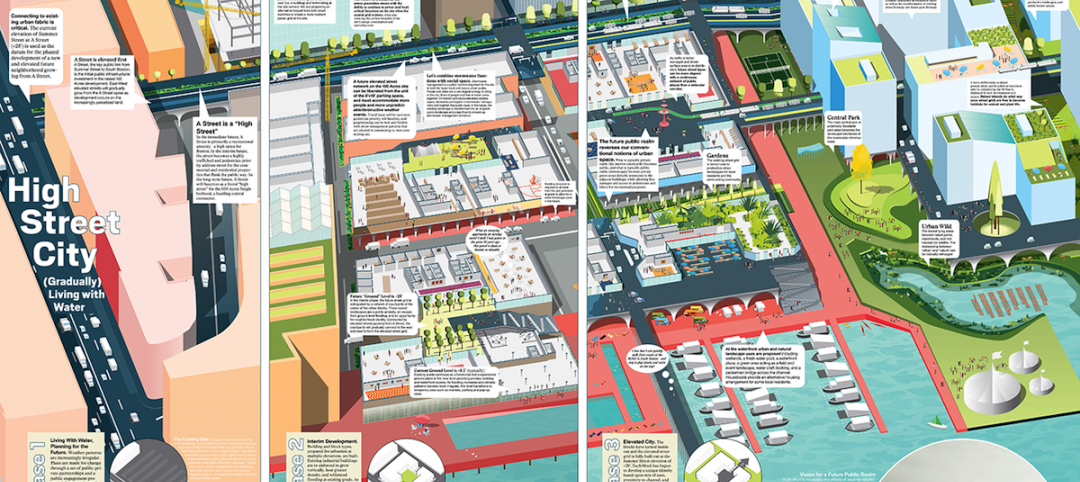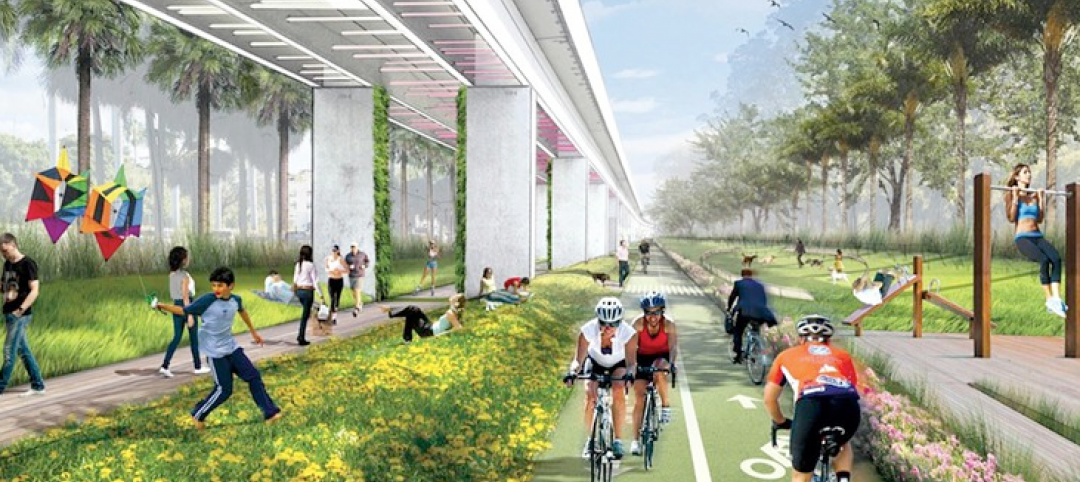Except for a few pockets of ultra-luxury condo action—New York, San Francisco, and parts of Florida, Hawaii, and metro Washington, D.C.—today’s multifamily story is all about rentals. “The apartment sector has been a darling for investors over the past two years,” notes the Urban Land Institute in its recent Real Estate Consensus Forecast. Vacancy rates are at an enticing 5.0%, and rental rates should be up 5.0% this year, although ULI does forecast some slippage next year, to 4.0%.
“Investors continue to view apartments as a preferred asset class in today’s environment,” says Dale Connor, Lend Lease’s Managing Director, Project Management & Construction, Americas. He sees developers playing catch-up to meet the growing demand for apartments, especially in the top five rental markets: New York City, Washington, D.C., Boston, Chicago, and Los Angeles.
SCROLL DOWN FOR GIANTS 300 MULTIFAMILY FIRM RANKINGS
Savvy market-rate developers are looking for locations around universities, innovation incubators, and teaching hospitals, says Ray Kimsey, AIA, LEED AP, President of Atlanta-based Niles Bolton Associates. Land that was once set aside for retail or office development is being looked at for multifamily, especially if served by urban transit.
“If you look at the hottest neighborhoods around Washington, D.C., Pittsburgh, or Baltimore, they all have an influx of Gen-Y people graduating and wanting to stay in that environment,” he says. Kimsey says there’s even a movement toward walk-up, garden-style apartments in some suburbs and second- and third-tier cities.
The use of urban infill sites is adding to the popularity of podium-style multifamily construction, says Mathew Dougherty, PE, Vice President with McShane Construction, Rosemont, Ill. “The podium ‘stacks’ uses vertically within the existing floor plate, thereby allowing a mixed format of ground-floor retail, parking floors, and residential floor plates,” he says.
According to John Lahey, AIA, Managing Principal at Chicago-based Solomon Cordwell Buenz Associates, the rental market is being shaped by two factors: service and community.
“Service” refers to the heightened demand for amenities: party rooms, surround-sound movie theaters, fully equipped fitness centers, mega-size video screens in common areas, computer golf games that let you play any course in the world, I-GO car rentals—even “restaurant days,” where a local restaurant comes in and sells takeout dinners one night a week.
There are even amenities for canine occupants. “People love their dogs,” says Lahey, so dog walks, dog parks, dog washing bays, and dog walking and grooming services are becoming de rigueur in many large (>400 units) complexes. “People want their lives to be easier,” he says. “They want to be taken care of.”
Tenants are demanding more green amenities, says Kimsey. “Expectations about energy conservation and sustainable features are now viewed as a basic right by many tenants,” he says. “If they lived in a LEED-certified residence hall in college they want a LEED apartment”—but not if it costs more than market rate.
“Community” refers to the renter’s need for connection, says Lahey. In past decades, apartment dwellers put a premium on privacy. Less so today. “A lot of people who move back into the city, they’re not confirmed urban dwellers, and they want to meet people,” he says. “The Starbucks in your building becomes the meeting place to get integrated into the larger community.” McShane’s Dougherty says wifi connectivity has become a given in new and renovated rental projects.
“The design must be hot,” says Kimsey. The units themselves may be “smaller, tighter,” but that means they must be more elegant and efficient, with open layouts and near-condo-like finishes. McShane’s Dougherty says granite countertops, stainless steel appliances, upgraded bathrooms, and high-quality flooring are expected, even in suburban garden apartments. Developers are increasingly concerned about sound attenuation, he says, so insulation choices, assembly details, and materials selection are crucial.
Looking ahead, SCB’s Lahey says that, unlike the condo market, apartment development needs to be left to the pros—firms like AMLI, Avalon Bay, Equity Residential, Forest City, The Habitat Company. “They have the track record, and they really do know what they’re doing,” he says.
“The money is out there,” says Kimsey, but it’s split between smaller projects being funded by S&Ls and smaller banks, and big projects attracting institutional and private-equity investors. Holding back the pent-up demand: anemic job creation, which limits new household formation.
Even with low mortgage rates, many potential buyers have become skittish about purchasing a home, says Lend Lease’s Connor. SCB’s Lahey cites mobility as another factor in rental’s favor, especially with the younger generation.
“People will like living closer in, and units will get bigger, something decent in size, and they’ll be willing to pay for it,” he says. “They’ll see a home as a place in which to live, not necessarily as an investment.” +
TOP 25 MULTIFAMILY SECTOR ARCHITECTURE FIRMS
| Rank | Company | 2011 Multifamily Sector Revenue ($) |
| 1 | IBI Group | 38,489,114 |
| 2 | Niles Bolton Associates | 13,772,650 |
| 3 | Solomon Cordwell Buenz | 12,000,000 |
| 4 | RTKL Associates | 11,397,556 |
| 5 | WDG Architecture | 9,817,297 |
| 6 | Perkins Eastman | 9,100,000 |
| 7 | HOK | 8,715,422 |
| 8 | Perkins+Will | 7,193,120 |
| 9 | ZGF Architects | 6,225,112 |
| 10 | Cooper Carry | 5,708,482 |
| 11 | Kohn Pedersen Fox Associates | 5,280,000 |
| 12 | Ziegler Cooper Architects | 4,853,598 |
| 13 | Harley Ellis Devereaux | 4,800,000 |
| 14 | PGAL | 4,607,900 |
| 15 | OZ Architecture | 4,104,475 |
| 16 | GBBN Architects | 3,700,000 |
| 17 | Smallwood, Reynolds, Stewart, Stewart & Associates | 3,605,928 |
| 18 | VOA Associates | 3,367,000 |
| 19 | Carrier Johnson + CULTURE | 3,324,072 |
| 20 | Skidmore, Owings & Merrill | 3,074,000 |
| 21 | Gensler | 2,800,000 |
| 22 | Rule Joy Trammell + Rubio | 2,600,000 |
| 23 | FXFOWLE Architects | 2,399,900 |
| 24 | HKS | 2,398,926 |
| 25 | Mithun | 1,906,000 |
TOP 25 MULTIFAMILY SECTOR ENGINEERING FIRMS
| Rank | Company | 2011 Multifamily Sector Revenue ($) |
| 1 | STV | 119,671,000 |
| 2 | AECOM Technology Corp. | 36,000,000 |
| 3 | Parsons Brinckerhoff | 32,800,000 |
| 4 | URS Corp. | 28,500,000 |
| 5 | Michael Baker Jr., Inc. | 23,620,000 |
| 6 | WSP USA | 17,200,000 |
| 7 | Jacobs | 16,000,000 |
| 8 | Atkins North America | 15,368,901 |
| 9 | Wiss, Janney, Elstner Associates | 14,372,000 |
| 10 | KPFF Consulting Engineers | 12,000,000 |
| 11 | Simpson Gumpertz & Heger | 9,740,000 |
| 12 | Thornton Tomasetti | 7,610,000 |
| 13 | Stantec | 6,345,000 |
| 14 | Clark Nexsen | 5,308,534 |
| 15 | Arup | 4,600,161 |
| 16 | Coffman Engineers | 4,000,000 |
| 17 | Magnusson Klemencic Associates | 3,556,559 |
| 18 | Rolf Jensen & Associates | 2,600,000 |
| 19 | Aon Fire Protection Engineering | 2,250,000 |
| 20 | Smith Seckman Reid | 2,227,000 |
| 21 | Paulus, Sokolowski and Sartor | 1,800,000 |
| 22 | Science Applications International Corp. | 1,530,000 |
| 23 | Lilker Associates Consulting Engineers | 1,500,000 |
| 24 | French & Parrello Associates | 1,396,720 |
| 25 | AKF Group | 1,300,000 |
TOP 25 MULTIFAMILY SECTOR CONSTRUCTION FIRMS
| Rank | Company | 2011 Multifamily Sector Revenue ($) |
| 1 | Lend Lease | 734,160,150 |
| 2 | Clark Group | 612,803,196 |
| 3 | Balfour Beatty US | 441,602,518 |
| 4 | Walsh Group, The | 342,877,063 |
| 5 | Whiting-Turner Contracting Co., The | 283,477,065 |
| 6 | Turner Corp., The | 223,410,000 |
| 7 | Swinerton | 186,340,000 |
| 8 | Harkins Builders | 180,000,000 |
| 9 | McShane Co., The | 175,000,000 |
| 10 | Yates Co., The | 173,900,000 |
| 11 | PCL Construction Enterprises | 159,105,415 |
| 12 | Bernards | 144,000,000 |
| 13 | Paric Corp. | 138,000,000 |
| 14 | Hensel Phelps Construction Co. | 137,700,000 |
| 15 | Weis Builders | 131,960,000 |
| 16 | CORE Construction | 125,513,227 |
| 17 | Suffolk Construction | 111,885,268 |
| 18 | Power Construction | 106,000,000 |
| 19 | Weitz Company., The | 82,000,000 |
| 20 | Austin Industries | 77,074,905 |
| 21 | Brasfield & Gorrie | 67,682,938 |
| 22 | Absher Construction | 61,807,647 |
| 23 | James McHugh Construction | 54,624,665 |
| 24 | Bette Co., The | 54,000,000 |
| 25 | Choate Construction Co. | 51,875,781 |
Related Stories
Religious Facilities | Mar 23, 2015
Is nothing sacred? Seattle church to become a restaurant and ballroom
A Seattle-based real estate developer plans to convert a historic downtown building, which for more than a century has served as a church sanctuary, into a restaurant with ballroom space.
Government Buildings | Mar 23, 2015
SOM leads planning for Egypt’s new $45 billion capital city
To alleviate overcrowding and congestion in Cairo, the Egyptian government is building a new capital from scratch.
BIM and Information Technology | Mar 23, 2015
Skanska hosts three-week 'hackathon' to find architect for Seattle tower development
Searching for a nimble, collaborative design firm for its 2&U tower project in Seattle, the construction giant ditches the traditional RFQ/RFP process for a hackathon-inspired competition.
Healthcare Facilities | Mar 23, 2015
Can advanced elevator technology take vertical hospitals to the next level?
VOA's Douglas King recalls the Odyssey project and ponders vertical transportation in high-rise healthcare design.
Healthcare Facilities | Mar 22, 2015
New Joplin, Mo., hospital built to tornado-resistant standards
The new hospital features a window and frame system that can protect patients from winds of up to 250 mph.
Sports and Recreational Facilities | Mar 19, 2015
Populous design wins competition for UK's most sustainable arena
The live-concert venue will seat an audience of 12,000, which the firm says will be masked by “the atmosphere and intimacy of a 4,000-seat amphitheatre.”
Architects | Mar 18, 2015
Architecture Billings Index rises in February
The ABI score was 50.4 last month, up slightly from a mark of 49.9 in January. This score reflects a minor increase in design services, according to AIA.
Multifamily Housing | Mar 18, 2015
Prefabricated skycubes proposed with 'elastic' living apartments inside
The interiors for each unit are designed using an elastic living concept, where different spaces are created by sliding on tracks.
Architects | Mar 18, 2015
Boston selects finalists in resilient design competition
The competition asks for creative approaches for planning for a not-so-distant future Boston where higher sea levels and more frequent flooding will be real and critical issues to contend with.
Cultural Facilities | Mar 17, 2015
The High Line’s co-designer wins contract for The Underline in Miami
James Corner Field Operations will design the master plan for this 10-mile restoration project.

















